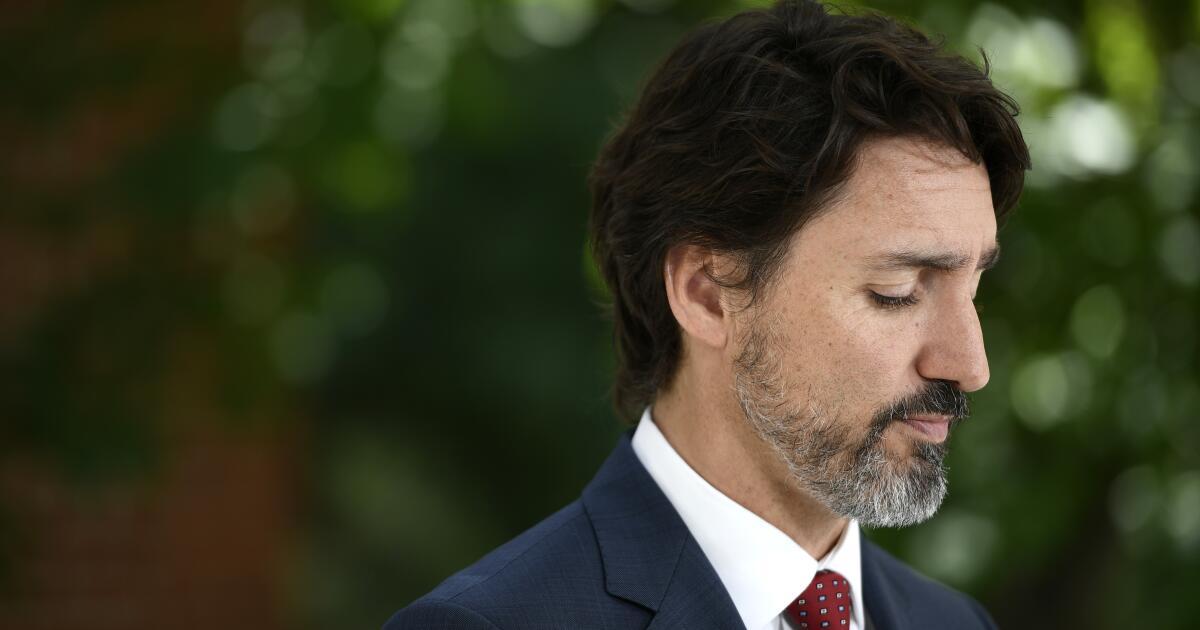Sports
Martin Brundle analyses chaotic Canadian Grand Prix, Max Verstappen’s win, criticism of Daniel Ricciardo and F1’s 2026 rules

That was a wild Canadian Grand Prix, three different race leaders dodging pop-up showers and stormy rain, quickly followed by bright sunshine, whilst navigating their way between the walls and slippery track furniture, and cars pointing in the wrong direction from time to time.
The top seven on the grid were covered by just over quarter of a second, and six of those drivers felt they should have been on pole position, including Fernando Alonso in sixth and a confused Lewis Hamilton in seventh. All felt that an error-free lap would have done the job.
In the end, George Russell delivered a lap on used tyres which was fast enough, and early enough, to put him ahead of Max Verstappen on the front row with an identical time to three decimal places. It would be terribly F1 for us to move to four or even five decimal places forthwith.
Lando Norris and Oscar Piastri bossed the second row for McLaren, followed by Daniel Ricciardo in fifth who was happy with that fine effort and not claiming he should have done better.
For the record, as it’s become a hot topic due to my Sky Sports F1 colleague Jacques Villeneuve expressing his firm opinions, I have fundamental respect for all F1 drivers, not least for Daniel and Jacques, because I know how hard it is to drive such fearsome cars under that spotlight.
Daniel has won eight GPs including an outstanding Monaco victory, scored 32 podiums, and has regularly shown world-class talent. But those results were quite a while ago and I wish he’d not left Red Bull at the end of 2018. That was an emotional and flawed decision, he should have faced up to Max in the best car, then he’d have necessarily raised his game even further.
Ricciardo never seemed to be quite the same driver again. He clearly still does have speed and race craft, as we witnessed also in the Miami Sprint, but something in his psyche or approach is holding that back and it’s costing him opportunity and longevity.
McLaren and Mercedes quicker than Red Bull
We can always rely on sporadic rain to spice up a Grand Prix and this was no exception. The early laps were all about watching the Haas drivers Kevin Magnussen and Nico Hulkenberg on ‘extreme wet’ tyres charging through the rest of the pack otherwise using the ‘intermediate’ tyre. Haas rolled the dice, and why not, as Kevin made it as far as fourth place. But the top teams had put faith in what turned out to be very accurate weather forecasts and the track came to their tyres just in time.
Russell led from Verstappen, with McLaren holding station, and before long they were all searching for wet parts of the track to cool the tyres. A couple of solid overtakes meant that Lando Norris was now leading and pulling away. One takeaway from the race is that, on intermediate tyres, McLaren were the fastest car would have won on sheer pace.
A safety car on lap 24 due to Logan Sargeant putting his Williams in the wall hurt McLaren. They must have known a safety car was imminent, but because Lando was a chunk ahead he was quite close to the pit entry, although could have made it in. They elected to go around and sadly he was scooped by the safety car, doing its job correctly, and this cost valuable time and track position. And possibly victory.
More rain meant that fresh intermediate tyres were required for a while and the lone Red Bull of Verstappen continued to slug it out with the two McLarens and effectively both Mercedes. There was some aggressive defending and overtaking going on, and, whilst not an all-time classic, this was a gruelling and memorable race.
The second takeaway is that once onto dry tyres, Mercedes were the fastest car and could have won on sheer pace. A critical error in Turn 8 while pushing hard cost Russell track position and the chance to attack Verstappen, who was getting along just about fine whilst managing suspension issues particularly in relation to riding kerbs.
There was a point where Hamilton was absolutely flying and recovering nicely having been tucked up behind Alonso in the first phase of the race. Lewis later described it as one of his worst drives, which wasn’t apparent to me but maybe he was making a lot of small errors here and there. The youngsters in front of him remain youthfully fast and fearless, but have a lot of experience too, and he’ll always need his ‘A game’ to match or beat them now.
Verstappen stars as Perez, Ferraris endure horror-shows
Despite all the challenges with weather, rivals, and safety cars, peerlessly emerging through it all for his 60th F1 victory was Verstappen. Behind him was a long story of ‘Shoulda, Woulda, Coulda’, to quote the fabulous Beverley Knight, but the reigning world champion simply did.
That made newly resigned Sergio Perez’s dismal weekend in the other Red Bull even worse. He qualified badly, had a front wing damaging skirmish in turn 2, didn’t progress much, then span off into retirement. Ouch.
Ferrari didn’t have much more satisfaction, if any. Still revelling in the glory of Monaco, from the outset they lacked pace around the circuit named after one of the most famous Ferrari drivers of all time, and that was in both the wet and dry. Charles Leclerc had power unit issues from 11th on the grid and took a wild gamble on slicks in a pit stop during which, ironically, they managed to fix his problem with an electrical reset.
Carlos Sainz from 12th on the grid didn’t progress too far either and would eventually have an underwhelming spin which would also eliminate the hard charging Alex Albon in his Williams, who memorably passed two cars in short order at one point.
That meant neither Ferrari nor Williams had a finisher. This left an open goal for both Aston Martins to score points in a significantly better showing, ahead of Daniel Ricciardo, who also soaked up a five-second penalty for clutch drag before the start lights extinguished.
The two Alpine drivers, who finished in P9 and P10 for their first double points score of the year, still managed some acrimony between them, but this time it was over team orders rather than contact.
Both Haas cars were under a second behind them but just out of the championship points.
Brundle’s verdict on 2026 F1 regulations
In other news, the dramatic changes proposed in the 2026 F1 regulations were announced during the event. In reality, they were somewhere between draft regulations and a technically driven wish-list, and were inevitably received somewhat sceptically within teams and the media.
In a nutshell, it’s far more battery power to make it roughly half and half sustainable fuel engine and electric propulsion. With correspondingly less downforce and drag to help the cars be more efficient in the usage of that electrical power, including active aerodynamics with the front and rear wings moving up and down as required on the straights and through the corners.
The cars will be a little smaller, the word ‘nimble’ was optimistically used frequently, and the target is to reduce the overall weight by 30kgs.
I like to be fundamentally positive about these things as they tend to turn out fine in the end once the FIA, F1, and teams combine their talents and mighty resource. F1 has had to evolve over the decades to remain cutting edge and relevant whilst somehow fulfilling its primary role of entertaining people.
Some are concerned that the cars will be too high on top speeds on the straights, and too slow through the corners in that aero format. I’d personally be a concerned about significantly moveable front and rear wings should they not return to the correct position for a very high-speed corner due to debris, damage, or malfunction.
Having said that, F1 throttle and brakes are controlled by wire and have been for some time.
The problem we have for 2026 is that the motor loses the MGU-H from the turbocharger which was very handy at generating electrical energy, and the new cars will not have any battery regeneration from the front wheels. And so, especially on circuits which have lots of straights and few big braking zones, it will be hard to generate the required amounts of energy for the significantly bigger battery. How that impacts on pure racing remains to be seen, and for those celebrating the imminent demise of the DRS rear wings, be careful what you wish for.
And knocking 30kgs out of a car that, albeit smaller, will have higher crash protection, active aero, and a bigger battery, will be quite the challenge. We’ll know soon enough; they’ll be on track in just 18 months and the teams by regulation can’t start the aero work until 2025.
I’ve been visiting the Canadian GP in Montreal since 1984, and this year was undoubtedly the least enjoyable in terms of the venue. The popularity and scale of today’s F1 has outgrown the facilities, and the rain turning accesses into mud didn’t help. The police and security appeared increasingly aggressive and unhelpful to boot, it was a logistical mess.
Next up Barcelona, the ultimate chassis and handling circuit, whereas the championship has been to a few specialist and quirky ones of late. The stopwatch will decide who’s been posturing, and which team really has improved their cars.
Formula 1 heads back to Europe as the championship moves on to Barcelona for the Spanish Grand Prix. Watch every session at the Circuit de Barcelona-Catalunya from June 21-23 live on Sky Sports F1. Stream every F1 race and more with a NOW Sports Month Membership – No contract, cancel anytime

















